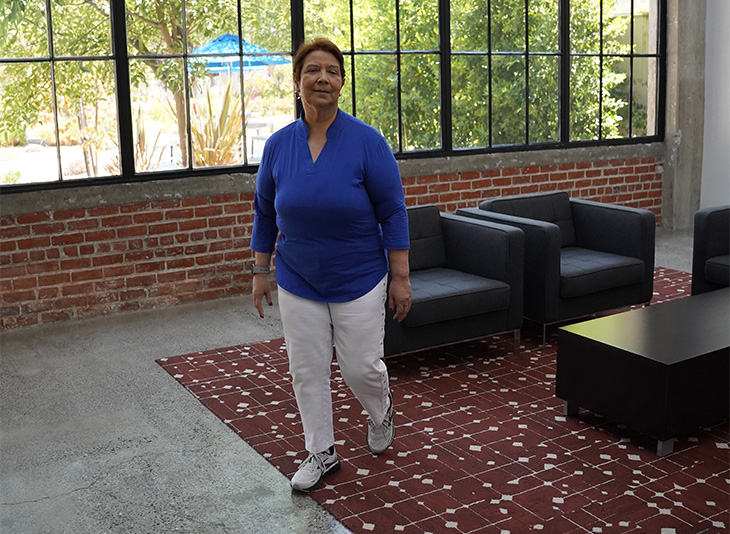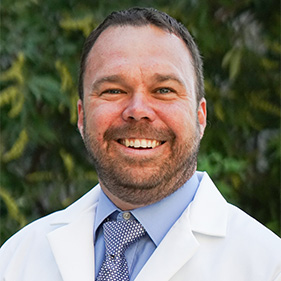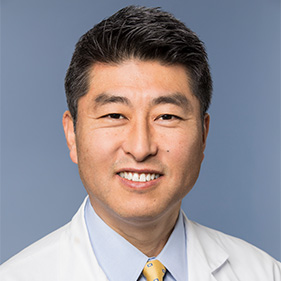Before Alma Contreras' surgery at the UC Davis Spine Center, the 62-year-old could barely stand due to pain from a pinched nerve in her lower back. Once someone who loved to exercise and dance, her back pain worsened to the point she couldn't drive and she hardly slept. As a kidney transplant patient, strong pain relievers were out of the question. Her daughter, Chenoa Vargas, had to take care of the necessities of daily life.
"The day of my surgery, the pain was out of control," Contreras said. "I couldn't stand at the front desk to register. I had tears just rolling down my face and couldn't stop them. That's how bad it was."
Fortunately, Contreras' surgeon, Richard Price, specializes in minimally invasive procedures. He performed a new type of outpatient endoscopic spine surgery to relieve the pressure on Contreras' nerve.
Price, an assistant professor in the UC Davis Department of Neurological Surgery, is one of only a few spine surgeons in the United States specializing in the procedure.
Because we're operating through such a small incision, patients don't experience the same damage to muscle and other tissue that we typically see during other types of surgery."-Richard Price, spine surgeon
UC Davis Health is the only facility in the Sacramento region to perform this type of surgery, which utilizes tiny 8 mm incisions to correct spinal disease. It can be performed without general anesthesia on some patients, and recovery is faster than with other types of spine surgery.
Immediately after the procedure to remove a portion of a herniated disc compressing her sciatic nerve, Contreras could feel a difference. She asked the nurse if she could walk on her own. "It was so wonderful to walk and have no pain," she said. "And this was within the first half hour after surgery."

Endoscopic spine surgery takes place through a tiny camera that fits through the surgical opening. Price docks the camera near the site of a patient's injury and uses miniscule tools to drill through vertebrae and correct spinal defects that are causing pain.
The most common cases he sees are herniated vertebral discs, though endoscopy can also be used for spinal stenosis, bone spurs, facet joint disease and foraminal stenosis. Price expects to begin performing endoscopy in complex surgical cases, such as spinal fusions, in the near future.
Faster recovery, dancing again
In contrast to traditional surgery, the recovery period for endoscopic spine surgery is a matter of days. "Because we're operating through such a small incision, patients don't experience the same damage to muscle and other tissue that we typically see during other types of surgery," Price explained. "That's why the time for recovery is so quick."
The endoscope and surgical area are constantly flushed with water during each procedure, significantly reducing the risk of infection. That's key for high-risk patients like Contreras, who remains immunocompromised after her kidney transplant.
Endoscopic spine surgery is not for everyone, but for select patients it is a fantastic option, and one that most hospitals don't offer." -Kee Kim, co-director of the UC Davis Spine Center
Kee Kim, co-director of the UC Davis Spine Center and chief of spinal neurosurgery, has seen firsthand how well patients recover after endoscopic surgery. He founded the UC Davis Endoscopic Spine Surgery Program this year. He expects that patients with increasingly challenging spine conditions will be able to choose outpatient endoscopy in the near future.
"At the Spine Center, we have all the leading-edge technologies to facilitate minimally invasive surgery," Kim said. "Endoscopic spine surgery is not for everyone, but for select patients it is a fantastic option, and one that most hospitals don't offer."
Contreras' daughter has been thrilled to see her mother transition from a life of immobility to one of independence.
"Without the surgery, I wouldn't have my mom back again, doing all of the things she loves to do — including dancing," Vargas said.
It was so wonderful to walk and have no pain. And this was within the first half hour after surgery." -Alma Contreras, endoscopic spine surgery patient
If you're debating whether to pursue endoscopic spine surgery, Contreras suggested listening to your doctor and taking an inventory of mobility issues.
"If someone had sat me down and pointed out that I couldn't even go to the grocery store or take out the trash, I would have started thinking about surgery as an option much sooner," Contreras said. "Look at what you're no longer able to do with your life and go from there."
Learn more about endoscopic spine surgery at UC Davis Health









